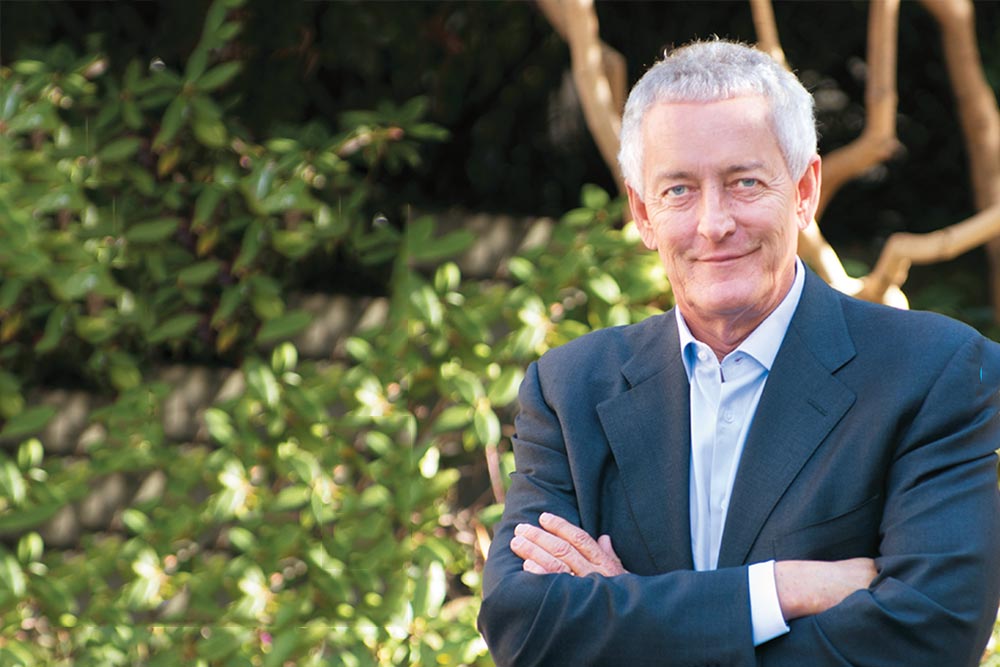We are in San Francisco on what is supposed to be the city’s most crowded weekend of the year. SF is expecting one million visitors to come in for various events — the Blue Angels air show, the America’s Cup World Series Race, the Hardly Strictly Bluegrass Festival, play-offs for major league baseball team San Francisco Giants and American football team San Francisco 49ers — lined up during the next two days. Nevertheless, we’ve agreed to brave the hustle and bustle of Union Square for the opportunity to meet Jason Jennings, one of the most sought-after motivational speakers in the US. Of all the personalities in the Masterspeak list, Jennings is the most colourful — he has been a broadcast journalist, a radio station owner, a media consultant and a writer. We’re waiting for him at a Starbucks outlet, which is particularly apt given that it is Jennings’ favourite example of how an upstart got everything right, lost its way and then reinvented itself. Once Jennings arrives, the conversation moves swiftly from Starbucks to Steve Jobs and how companies fail because they can’t let go.
Since we are sitting at Starbucks and you’re an admirer of the company, let’s start with a Starbucks question. What sets it apart?
I can tell you exactly what sets it apart. As it happens, I went to university with Howard Schultz, the CEO of Starbucks. We both started at Northern Michigan University and knew each other a long time ago. Here is what makes it great. Schultz built this iconic brand into about 13,000 locations around the world at that time. In 2001, he said, I am done with this and I want to do some other things with my life. He stepped down as CEO. Immediately, the tom-tom drums began in the US that coffee was going to be out of favour and would be replaced by energy drinks and tea; Starbucks was a one-trick pony and it would fade; and that it had got as far as it could go. Soon enough, that started happening and performance started slipping. Starbucks started losing revenue. They were at $11 billion and fell to $8 billion; they lost 30% of their revenue — that’s significant.
Schultz came back in and the first thing he did was take 10,000 Starbucks workers to New Orleans and said, “My colleagues, the world thinks that Starbucks has been about coffee, but it has never been about coffee. It has been an opportunity for you to grow and prosper. But you will not have more money, promotions and your own store unless we grow.” And then he suggested something brilliant to get going again. Schultz said they were about to become the master practitioners of small bets. They would make about 10 small bets a month, and in his first 18 months, they made some 150 small bets.
A small bet was new store design, it was testing beer and wine sales, which they have now dramatically expanded, it was dessert wines, Via instant coffee, mobile payments, Twitter feeds on everybody’s desk at headquarters so they would see in real time what the world was saying about them. The big one came when somebody said, “Have you ever thought about oatmeal?” Within a couple of weeks, they were testing oatmeal at a couple of stores and then they got rolling it out very quickly. Now, Starbucks oatmeal sells at about $3. An average store sells around 20 of them a day. There are 18,000 stores around the world, which means that one small bet immediately became $450 million. It is extraordinarily significant.
What is the secret to making small bets work for you as an organisation, especially when you are a large company?
Yes, there is a rule. We call that the “no-skunking” rule. We all know what skunks do when they are cornered and frightened — they spray. What happens is that intentionally or unintentionally business leaders skunk the ideas of the time. Starbucks has a skunking-free environment. Everybody gets listened to and almost every idea gets tried. Their approach is that we are going to try it and if it works, we are going to scale it up as quickly as we possibly can. If it doesn’t work, we are just going to get rid of it and laugh about it. We will ask ourselves what we learned and move on. So no skunking, fail fast and then sadly what happens in most companies is that they look for someone to punish. In Starbucks, they are looking to learn and grow, not punish.
What determines failing fast? Is it the timeframe or the budget, after which you say, let’s move on?
Let me tell you about this company called Nucor Steel, which is the biggest domestic producer of steel in America. They did a couple of amazing things to establish their hegemony. In the past 10 years, 35 major American steel companies have gone through bankruptcy, Nucor has not. Their average steel worker last year made $130,000. The company has never had a layoff in its history. CEO Dan DiMicco thinks layoffs are illegal, immoral, unethical. They have never had one for 40 years. To deal with a slowdown five-day weeks have given way to four-day weeks for the entire company, including executives.
They also do other things. For example, they foot education expenses of children for all employees, barring executives because executives make enough money to pay by themselves. They now have a company of roughly 22,000 employees but they run it from a home office in Charlotte, North Carolina, with less than 100 employees. I once asked DiMicco about their R&D facility, and he said, “Jason, we have got 22,000 people in our R&D team because every idea that everyone comes up with is tried. The average base salary of our workers is about $40,000 a year. The rest is based on how much error-free safely-made steel they make in a year.” They have a saying at Nucor, “If it is worth doing at Nucor, it is worth failing at Nucor.”
How can companies develop an unconventional mindset without risking it all? The tendency is to feel that if you go with conventional wisdom you are not risking anything.
I have never met a company any place in the world wanting to achieve conventional results. Everybody wants to achieve unconventional results. What do you do, then? Our research tells us: embrace unconventional wisdom. To make some bets, you have to be willing to let go, and the inability to let go is far more damaging than any threat of competition. Now, what is it that you need to let go?
Number one, let go of yesterday’s bread winners. In India, you call them legacy brands. Every product and service has an S curve. When it is introduced in the marketplace, it begins to find favour and then faces an inevitable decline for several different reasons. But by the time the product is at the bottom of the S curve, the organisation has to be willing and able to find a replacement that is relevant. Most companies can’t do that. They spend a disproportionate amount of time trying to perform artificial resuscitation on something that is dead on arrival. One of my favourite examples is General Motors, which deserved to go bankrupt because of decades of errors in decision making. No better the instance than the story of one of their brands, the Oldsmobile.
This brand had been losing money for years but GM refused to let it go. Instead, the company formed a committee to save Oldsmobile and these people would fly around in private jets, stay at Ritz Carlton and strategise. At the end of two years, they said, “In the average year, we spend $100 million advertising Oldsmobile. This year, we are not going to spend $100 million, but $500 million.” They said that Oldsmobile was a superior vehicle, so it was really the ad agencies’ fault, so they fired the agency and hired a bunch of young people to come up with an existing campaign. They then proceeded to spend $500 million in advertising and the line was this: It is not your father’s Oldsmobile. The problem is the market knew that it wasn’t your father’s Oldsmobile — it was your grandfather’s Oldsmobile, for god’s sake.
Second, companies have to be able to let go of ego. Not too many years ago Jim Collins wrote about Circuit City as being one of the most enduring brands in America. They are not even in business anymore. Why? You think you are the best and don’t embrace change.
The other thing that you have to let go of is “same old same old.” Take a look at Research in Motion that owns BlackBerry. Two years ago the market capitalisation of BlackBerry was $50 billion, today it is $7 billion. How is this possible? Because of this stupid saying: “If it ain’t broke, don’t fix it.” So companies wait until something is broken and turn their people into firefighters. They made a conscious decision to suck as much money out of the 9xxx Series as they could, postponing the 10 Series. They said they will release it in 2010, then 2012, now hopefully it should come out in 2013. Well, guess what? The world went someplace else in two years.
Which companies have thrived by “letting go”?
We have already talked about Starbucks. I think that they proved themselves masters of letting go by virtue of their ability to make 150 small bets over 18 months and then letting go of 136 of them. I will tell you another story and it is about a funeral home company called Anderson McQueen. To make a bad pun, the funeral home business is a dying business. I mean, if everybody is opting for cremation, their business model is turning to ashes, but Anderson McQueen just turned their business model completely upside down. If you walk into their campuses today, it will be the most uplifting experience that you will ever have in your life. They have Starbucks restaurants. They have outdoor barbeque areas for family gatherings. They perform services for pet owners. There is beautiful music and video tributes being done. They have taken the ceremonial thing to a whole new level. But first they had to let go of everything that they were doing.
I’ll give you another example — Koch Industries, it’s perhaps the biggest privately held company with a revenue of $120 billion. They are involved in more than 400 business activities around the world. Charles Koch, the head of the company, is a delightful man. Every year he sits down with his 400 business unit heads and asks them only two questions. Number one, “Has your business unit created authentic value for your employees, for the customers and suppliers and for me the shareholder in the past 12 months?” If the answer is yes, he then asks them a second question, “Has your business unit been a good steward of capital over the past 12 months? Have you paid your own way?” If the answer is yes, he then asks them to show the business plans for the next 12 months. If the answer is no, he would say, “We are going to sell it, shut it down or give it away because we will never be involved in any business activity that does not generate value for the stakeholders every year and is not a good steward of capital.” You might think that those are empty words. But over the past 10 years, they have shut down or sold off more than 100 businesses.
Isn’t letting go dictated by your corporate structure — if you are a privately-held company, it’s easier to let go?
Let me then give you another example. Steve Jobs. He was a master of letting go. At any point in time, Apple is working on 200-300 new products and 100 new innovations. How many have we seen? We have seen two or three. What happened to the others — the other hundreds didn’t pass muster and they let them go? They didn’t bring them to market. I think letting go is the spirit. And letting go becomes part of the culture. That culture, of course, comes from the person at the top. Most CEOs don’t spend a lot of time on culture. When you don’t spend a lot of time on culture you end up with a culture of default — everybody out for themselves.
Does culture have to do with performance and growth?
At some point, it all comes down to whether or not an organisation is committed to growth. When they make a decision that they have to grow every single year, it is a lot easier to embrace many of these things that we have talked about so far today.
About a year ago, I was giving a speech in Ohio to a small, $100 million company and the CEO asked, “We have been hit by recession last year and our growth is down. Can you give us any tip that will help achieve this annual double-digit improvement in performance?” I called him to come up where I was and said, “Next year you will either achieve double-digit improvement in your annual financial performance, or I have a gun pointed at your head. Do you think you will achieve your targeted financial performance?” I took my hand away and he said, “Oh my god. I get it.” If we put ourselves in that kind of financial pressure we will force ourselves to ask all kinds of questions and do whatever needs to be done.
This whole idea of putting the company under pressure to achieve double-digit performance, isn’t that exactly what Wall Street does to a company? Isn’t it the reason why companies fail to take a long-term approach.
I think the difference between the two is that the pressure that you put on yourself is a lot better than pressure being put on you by outside forces. A kid is in advanced algebra and has decided that he wants to be the topper in his class. He was doing 20 hours a week as coaching, 10 hours of the week with a tutor, and 10 hours out on the road. He scored the highest marks in the class. That is pressure he is putting himself under. If I were to say, “You will study algebra so many hours a week”, that wouldn’t fly.
In either case, if there is an opportunity for achieving double digit growth every year, isn’t that going to result in short-sightedness?
No, I don’t think so. Ikea has done that for the past 35 years. That is how they stay ahead of the customer. That is why they look at newer markets. So, Ikea is keen on India because it offers growth. I define an annual double-digit growth in financial performance as 5-6% organic growth, improve your efficiencies to improve your profitability by 3-4%, and occasionally buy something. I don’t think those are big numbers at all.
But that is a private company… Often, there is a conflict between what is good for shareholders and other stakeholders. How do you then balance that out?
There is a great story. The story is that a new person was promoted to CEO. He showed up on the first day of work and there was a note from his predecessor on the desk and it said, “I have left three numbered envelopes in the top desk drawer for you. Whenever you face a crisis open up envelope Number One.” This CEO begins his job. Predictably, about six months later, there is a crisis. So he opens envelope Number One, which says, “Blame it on me, your predecessor”. He does that and everything calms down. About a year later, he runs into a major problem and opens up envelope Number Two. It says, “Announce a major reorganisation.” He does that and everything calms down and he gets some more time. Finally, six to eight months later he runs into another problem and he opens up envelope Number Three which says, “Write three letters.” The problem is, with the average CEO in America serving a very short tenure (3.2 to 3.5 years), they are often trying to enrich themselves and secure their financial future with callous disregard for the long-term health of the enterprise.
Based on our research, a company will only truly change when one or two conditions exist: one, when they are about to go over the edge of the cliff, then they will say, “Oh yes, we will do whatever needs to be done.” The problem is that there are no resources then to save them. Two, when a new MD or CEO comes in, they have an opportunity to change.
But what prevents executives from caring about the long term interests of all the stakeholders is the fact that many companies still give guidance to Wall Street. When you do that you are no longer operating in the interests of all stakeholders. If you give short-term financial guidance, you become a short-term company — close a factory, fire a thousand people, do whatever you have to do to hit this quarter’s numbers. The sad part is, you can’t repeat that over and over again.











